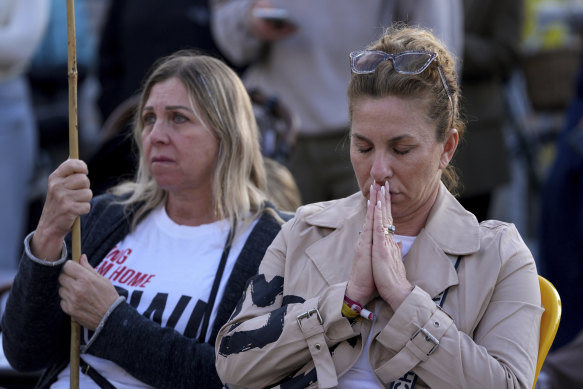In the north of the territory, where some of the most intense Israeli airstrikes and battles with militants took place, people made their way along narrow paths through a devastated landscape of rubble and twisted metal.
Relatives and friends of people killed and kidnapped by Hamas gathered in Tel Aviv as the hostage exchange took place.Credit: AP
Armed Hamas fighters marched through the southern city of Khan Younis as crowds cheered and chanted. Hamas police, dressed in blue police uniforms, were deployed in some areas after months of trying to stay out of sight to avoid Israeli attacks.
People who had gathered to cheer the fighters chanted “Greetings to the Al-Qassam Brigades,” the armed wing of Hamas.
“All resistance factions remain despite (Israeli Prime Minister Benjamin) Netanyahu,” one fighter said.
“This is a ceasefire, a whole and complete one God willing, and there will be no return to war despite it.”
The ceasefire agreement comes after months of on-again, off-again negotiations mediated by Egypt, Qatar and the United States, and comes into effect on the eve of the inauguration of US President-elect Donald Trump, who had said he would “pay hell” unless The hostages were released before he took office.
Little remains of many areas of Gaza. Displaced Palestinians are shown here leaving Khan Younis to return to their homes in Rafah.Credit: AP
There is no detailed plan to govern Gaza after the war, much less to rebuild it. Any return of Hamas to control of Gaza will test the commitment of Israel, which has said it will resume the war unless the militant group that has ruled the enclave since 2007 is completely dismantled.
Hardline Israeli National Security Minister Itamar Ben-Gvir resigned from the cabinet on Sunday over the ceasefire, although his party said it would not try to overthrow Netanyahu’s government. Another prominent hardliner, Finance Minister Bezalel Smotrich, remained in the government for now, but said he would resign if the war ended without Hamas being completely destroyed.
Trump-appointed national security adviser Mike Waltz said that if Hamas reneged on the deal, the United States would support Israel “in doing what it needs to do.” He didn’t provide any qualifications in terms of what that would entail.
“Hamas will never rule Gaza,” he said. “That is completely unacceptable.”
Destroyed streets
The streets of the destroyed city of Gaza, in the north of the territory, were already busy with groups of people waving the Palestinian flag and filming the scenes with their mobile phones. Several cars loaded with household goods were driving along a road strewn with rubble and rubble.
Gaza City resident Ahmed Abu Ayham, 40, who is sheltering with his family in Khan Younis, said the scene of destruction in his hometown was “appalling,” adding that while the ceasefire can having saved lives, it was not a time for celebrations.
“We are suffering, deep pain and it is time for us to hug each other and cry,” he said.
Long lines of trucks carrying fuel and relief supplies formed queues at border crossings in the hours before the ceasefire went into effect. The World Food Program said they began crossing Sunday morning.

Some displaced Palestinians returned to Rafah on Sunday after a ceasefire was established.Credit: AP
The deal calls for 600 truckloads of aid to be allowed into Gaza each day during the initial six-week ceasefire, including 50 with fuel. Half of the 600 aid trucks would be delivered to northern Gaza, where experts have warned that famine is imminent.
The war between Israel and Hamas began after militants stormed Israeli cities and towns on October 7, 2023, killing 1,200 people and capturing more than 250 hostages, according to Israeli counts.
Since then, more than 47,000 Palestinians have been killed in Israeli strikes that reduced the Gaza Strip to a wasteland, according to medical officials in the enclave. Nearly all of the 2.3 million people who live there are homeless. Around 400 Israeli soldiers have also been killed.
AP, Reuters
Get a note directly from our foreigner correspondents about what’s making headlines around the world. Subscribe to our weekly newsletter What within the World.





